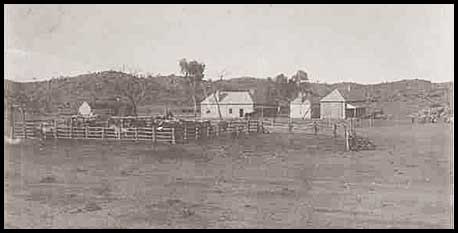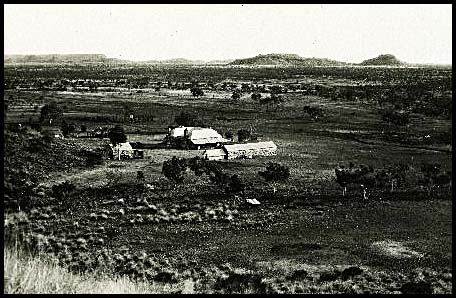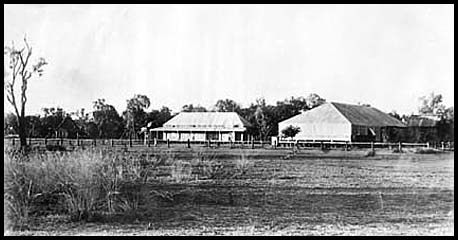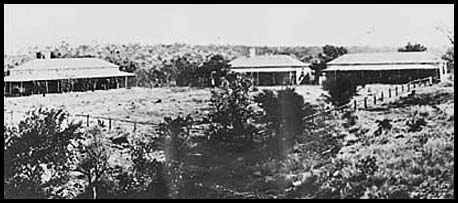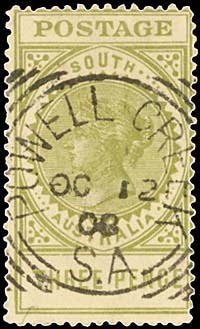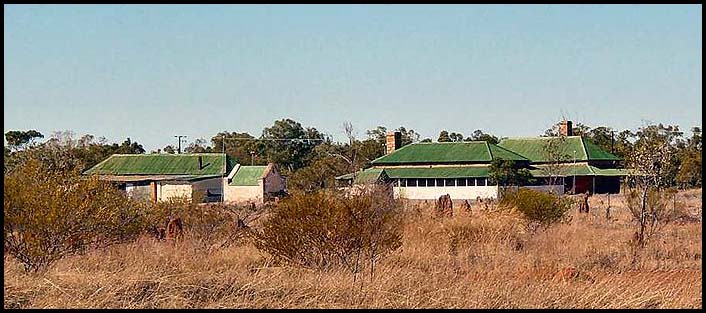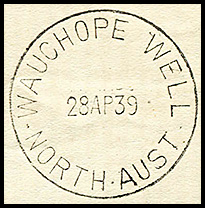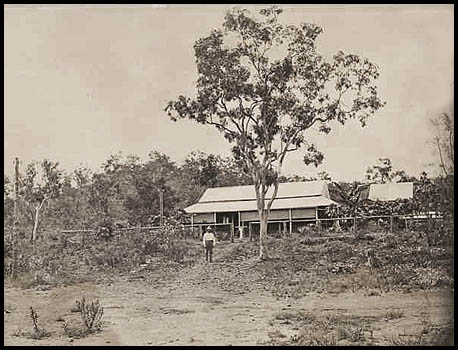Telegraph Offices along the Overland Telegraph line.
- Australia 1901-1988
- New South Wales
- Queensland
- South Australia
- Tasmania
- Victoria
- Western Australia
- International
- Special aspects
The Telegraph Offices included in the table below were located on the Overland Telegraph Line - see the map in each of the construction sections. Darwin Telegraph Office is discussed separately.
| Alice Springs | Barrow Creek | Beltana | Charlotte Waters | Daly Waters |
| Elsey | Farina | Katherine | Palmerston | Peake |
| Pine Creek | Powell Creek | Southport | Strangeways | Tennant Creek |
| Wauchope Well | Yam Creek |
In 1872/73, temporary stations were placed during the wet season at the Alberga, between the Peake and Charlotte Waters, and at the Elsey, between the Daly Waters and the Katherine.
The distances of each station along the total of 1,973 miles from Post Augusta to Palmerston are shown for each entry. Repeater stations were set up about every 250 km along the line. At these, telegraphists repeated each message to the next station. The four linesmen based there patrolled the section of line assigned to that station.
In his Report printed in the Adelaide Observer of 11 January 1873, Todd noted that " in the interior we have six persons at each station, viz., the Stationmaster, Assistant-Operator and four men. There are also about 20 horses — draught and saddle — and in most cases a team of bullocks besides spare bullocks for food. The stations are all well provisioned - most of them up to the end of 1874".
The more remote stations (everything is relative!!!) became self sufficient villages. Once each year the station received a delivery of supplies - carted there by camel train.
In the 1930s, the repeater stations were transferred to the nearby town Post Office.
|
|
Prestige Philately September 2011 Lot 464. |
| Barrow Creek
The Telegraph Office was opened on 24 August 1872. On 18 December 1914, the Office was upgraded to a Post & Telegraph Office. The building was a substantial stone structure of eight or nine rooms and roofed with galvanized iron. The stone work was estimated to be 700 yards in length - and it was erected by one man!! Todd visited the Station about the middle of 1872. The site was chosen because it was immediately north of Forster Range. There was surface water there, which could be regarded as permanent, but in the event of it failing, water was obtainable by sinking at a depth of 10 or 12 feet. A major incident at Barrow Creek was the 1874 attack by aboriginies which killed two station staff. Distance from Adelaide: 1,207 miles or 1,973 kms. |
|
 Telegraph Operators at Barrow Creek about 1925. Source: State Library of South Australia 62578. |
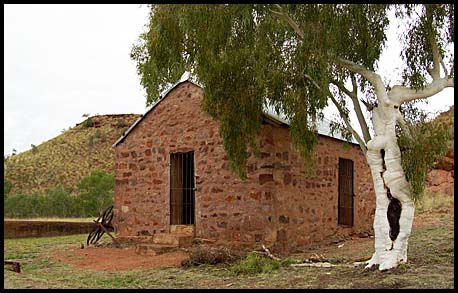 Barrow Creek Telegraph Station in the 21st century. |
| Barrow Creek was not issued with a special date stamp for use with telegraphic business. The Office used a squared circle date stamp from South Australia on all telegram-related matters.
Only one example of the use of this date stamp is recorded during the Telegraph Office period to 1914. Rated: RRRR. |
 13 April 1910. Squared circle date stamp applied to a 1/- brown POSTAGE long stamp from South Australia during the Telegraph Office period. |
The South Australian Register of 24 February 1874 describes a bit of history involving Barrow Creek: Mr. R. C. Watson, the former Telegraph Master at Barrow's Creek, on the Adelaide to London line, has sent to the Melbourne Argus the following clear contradiction to a crucial part of Andrew Hume's apocryphal story:
|
|
Charlotte Waters.
|
|
| The Telegraph Office was opened in January 1878. Prior to that, it had served as a repeater station in Knuckey's section A. It was a substantial stone structure of eight or nine rooms and roofed with galvanized iron.
The site was chosen because there was a chain of beautiful lagoons with fresh water in Duffield Creek which was a tributary of the Finke. Knuckey had discovered these lagoons on 10 January 1871 and named them Charlotte Waters in honour of Lady Charlotte Bacon, the mother of Harley Bacon the storekeeper in Knuckey's Section A of the Central part of the line. |
|
| In the event of the failure of the immediate water supply, other permanent waters were available. In addition, tanks to hold 20,000 gallons were constructed at the station. Mr. Knuckey also reported there was good building stone there.
Distance: 804 miles of 1,973 miles. |
 Charlotte Waters in 1925. Source: National Librry of Australia B62538. |
|
The Telegraph Office In 1920, during a discussion about history, a person raised the question as to whether the Elsey Station spoken of in the book "We of the Never Never" could be classed as being in the Never Never. The answer was NO because, if one so desired, he might have a telegram each day from the Elsey Telegraph Station. |
|
| An amazing document showing the staffing in the 1880s at Elsey and D.W. (Daly Waters).
It would be interesting had the document been dated - G. Dewar had left on 8 July .... |
| Katherine.
The Telegraph Office was opened on 22 August 1872. On 1 April 1883, the Post Office opened and was amalgamated with the Telegraph Office. In 1910, the combined office was reclassified into an Official Office. A building similar to that at Daly Waters was built at the Katherine. It was a large and substantial log house of six rooms, roofed with galvanized iron. Distance along the line: 1,771 miles of 1,973 miles. |
|
 Katherine Telegraph Office about 1890. |
|
Although no special date stamp for use with telegrams was issued to Katherine, the postal date stamp was used to cancel postage stamps which were used to pay telegraphic costs.
|
 22 May 1910. |
Later a special date stamp was issued to the Office when telephones were frequently used because of the distance customers would have had to travel to lodge telegrams personally. Telephoning messages to the Telegraph Office was called the Phonogram Service.
|
 3 August 1979. |
|
The Telegraph Office was opened in March 1869 as the northern end of the possible Overland Telegraph Line. In March 1873, the Palmerston Office was relocated as the Port Darwin Telegraph Office. |
|
| Peake.
The station at the Peake was one of the three repeater stations in the southern part of the line. The Telegraph Office itself was actually built from stone in January 1871, under Todd's instruction, as a store in which to keep the rations. On 24 June 1871, tenders were let for the supply of building materials for the Peake Telegraph Station itself - for the cost of £75 1s 11d. |
|
It was a substantial stone structure of eight or nine rooms and roofed with galvanized iron. On 1 October, 1871 the bricklayers were still busy completing the Station-master's residence and offices. When those were finished and trees planted round about, it was apparently "a very pleasant-looking place". In January 1872, Mr. A. Baldock, formerly of Goolwa, was appointed as the Station Master at the Peake — a position rendered vacant by the death on the Overland Line of Mr. Kraagen. Distance: 636 miles of 1,973 miles. |
|
| Pine Creek.
Pine Creek was not listed as being on the line even as late as September 1872. This omission was surprising because of the gold mining operations in the immediate vicinity especially north at Yam Creek. The Telegraph Office did however open in November 1873, closed soon after only to reopen in December 1873. It closed again on 19 August 1881 - and then re-opened on 1 September 1884. It then closed so as to merge with the Post Office on 30 September 1889. Distance: 1,825 miles of 1,973 miles. |
|
|
|
 Pine Creek. 5 May 1908. |
|
| Powell Creek.
The first station built at Powells Creek was only a temporary hut at because the building materials were still being held at the Roper River. It was a repeater station. A more permanent Telegraph Office was opened on 1 March 1874 with Mr. C. H. Johnson as the Station Master. Distance: 1,467 miles of 1,973 miles. |
|
|
|
|
On 4 August 1873 the Argus carried the report "The Southport Telegraph Station has long been finished but there is no operator yet stationed there or at Pine Creek". The Telegraph Office was finally opened on 21 August 1873. It was the first Office on the line south from Palmerston.
|
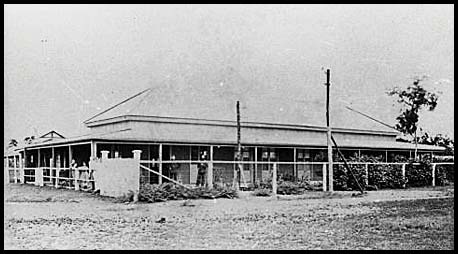 Southport Post & Telegraph Office about 1886. |
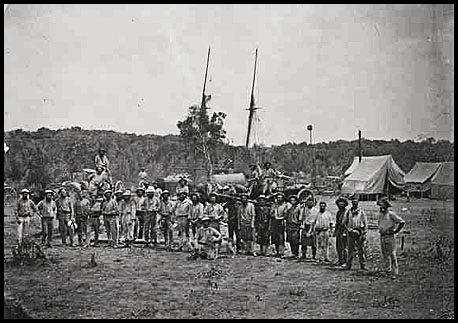 OTL employees at Southport about 1870. OTL employees at Southport about 1870. |
 Tumbling Waters near Southport about 1870. Photograph by Charles Sweet. Source: State Library of Victoria H24575. |
|
Wauchope (pronounced Walk-up) - and referred to by the locals as "The Wauchope" - is situated about 114 km south of Tennant Creek. It was not established during the construction of the Overland Telegraph Line. Indeed it was not inhabited until mining for Wolfram started in 1938. The Telegraph Office opened on 1 April 1939 - clearly to serve the mines. It was upgraded to a Post Office on 1 Jult 1952 but then reverted to a Telegraph Office on 1 November 1968. The Office closed on 22 July 1981, |
|
No special date stamp was issued to the Office for use with telegrams. Instead the usual postal date stamp served the principal use for telegrams but also was used for postal articles.
|
|
| Yam Creek.
Yam Creek was a small gold mining town which took its name from the contiguous gold-field which bordered Yam Creek. Yam Creek was about 45 kms from Pine Creek which in turn was about 12 kms from Union Reef. Overall, Union Creek was about 170 kms south-east of Darwin. Mail from Union Reef and Pine Creek would be sent to Yam Creek to be forwarded to Palmerston. A temporary Telegraph Office opened at Yam Creek shortly before 26 August 1872 for the receipt and dispatch of messages. The Telegraph Office was regarded as being the intermediate station along the Overland Telegraph line between Katherine and Port Darwin. Construction was completed during January 1873. It was a substantial three-roomed hut built of cypress pine and roofed with galvanized iron. Distance: 1,854 miles of the 1,973 mile line. For further details on Yam Creek see elsewhere. |
|
|
A telegram to AAP in Adelaide of 30 August 1872 noted that "an auriferous reef has been discovered near the telegraph station at Yam Creek and is traced for a distance of three miles. Gold is visible to the naked eye within a radius of 150 yards of Yam Creek. Ten claims have been taken up and pegged out". The Northern Australian of 16 April 1887 reported on a petition from the residents of the goldfields districts to the Acting Government Resident in Palmerston:
|


